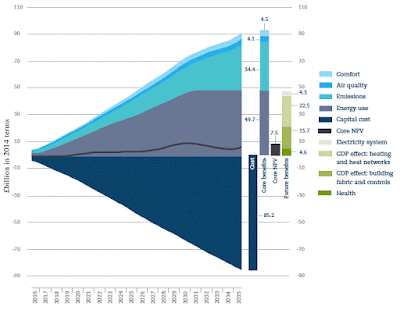A version of this article appeared on The Fifth Estate on 18 September.
In Britain, as a result of efficiency savings in products and efforts to make homes more efficient, homes now use 23 per cent less gas and 17 per cent less electricity than in 2008. Moreover, the average dual fuel household bill was £490 lower in 2015 than it was in 2004, according to the report from the UK Energy Research Council (UKERC).
The report says homes could save a further average of £270 a year at current energy prices, totalling about 140 terawatt-hours (TWh) – or the rough equivalent of the output of six Hinkley C-sized nuclear power stations – in heat and electricity.
This implies that the UK government would be much better off rekindling its home energy efficiency program – moribund for six years – than investing in new nuclear power stations – although much more electricity will be needed to charge the growing number of electric vehicles.
The report (using the government’s own guidance for policy appraisal) says that such investments would deliver net benefits worth £7.5 billion to the UK economy. This could rise to £47 billion if benefits such as health improvements and additional economic activity are counted.
The UKERC is therefore calling for the government to set a long-term target for energy efficiency – as it did on 26 July with a target to ban petrol and diesel cars by 2040 (a target beaten by eight years by the Scottish Government’s announcement to phase them out in 2032, made five days later).
The Committee on Climate Change believes that as much as 85 per cent of potential carbon emission savings in buildings are at risk of not being realised due to poor take-up of measures, implementation or standards enforcement.
The UKERC report makes an estimate of which of these savings are achievable under three scenarios of increasing ambition:
This makes clear that more efficient appliances and boilers are easy wins – mostly thanks to EU policies (we won’t mention the ironies of Brexit here) driving greater efficiency in household appliances and boilers, and a new EU Regulation setting a framework for energy labelling, which simplifies and updates the energy efficiency labelling requirements for products sold in the EU.
The tough ones are help with insulation – particularly of walls and floors – and heat pumps. It is here where government support could therefore be most usefully targeted.
This graph shows where savings could be made over the next 18 years, and how much impact savings in different areas will make, compared with making no savings at all (the top dotted line):
What is the cumulative value of this investment in the energy efficiency of the housing stock? The report analyses this in the “cost-effective” scenario. In the graph below, anything below the horizontal line is a cost compared to current levels, and anything above is a saving.
It shows that while the core savings come from energy use and a reduction in emissions and pollution, this has a knock-on benefit in health savings and GDP.
Source: produced from BEIS, 2016 using outputs from CCC dataset model
“With innovation in technology and delivery, appropriately supported by government, it is likely we can go significantly further than this too.”
But to do so there needs to be significant policy change and public investment. The report points to the forthcoming opportunity in the expected (and delayed) Clean Growth Plan and National Infrastructure Assessment. Plus, to fill the current policy vacuum a new white paper on heat and energy efficiency is urgently required.
Two years after the government scrapped its Green Deal energy efficiency loan scheme, it has yet to announce a replacement. The company which bought the Green Deal Finance company (and some of the Green Investment Bank's investments from Macquarie) is also yet to announce a new scheme.
David Thorpe is the author of Energy Management in Building and Sustainable Home Refurbishment.




No comments:
Post a Comment